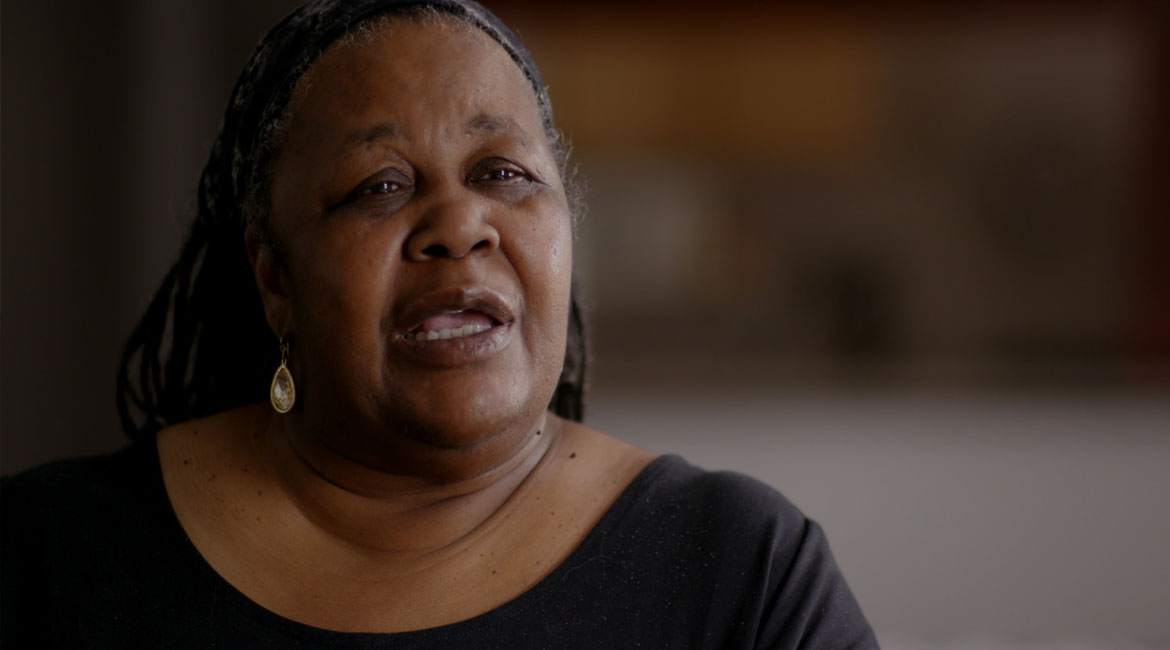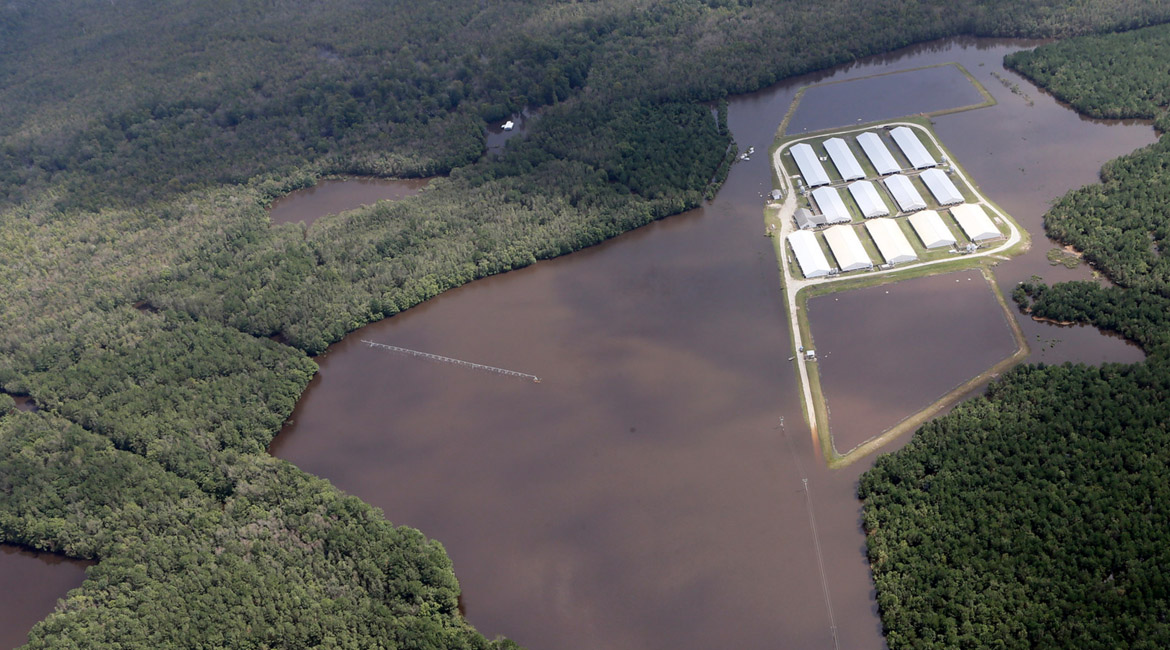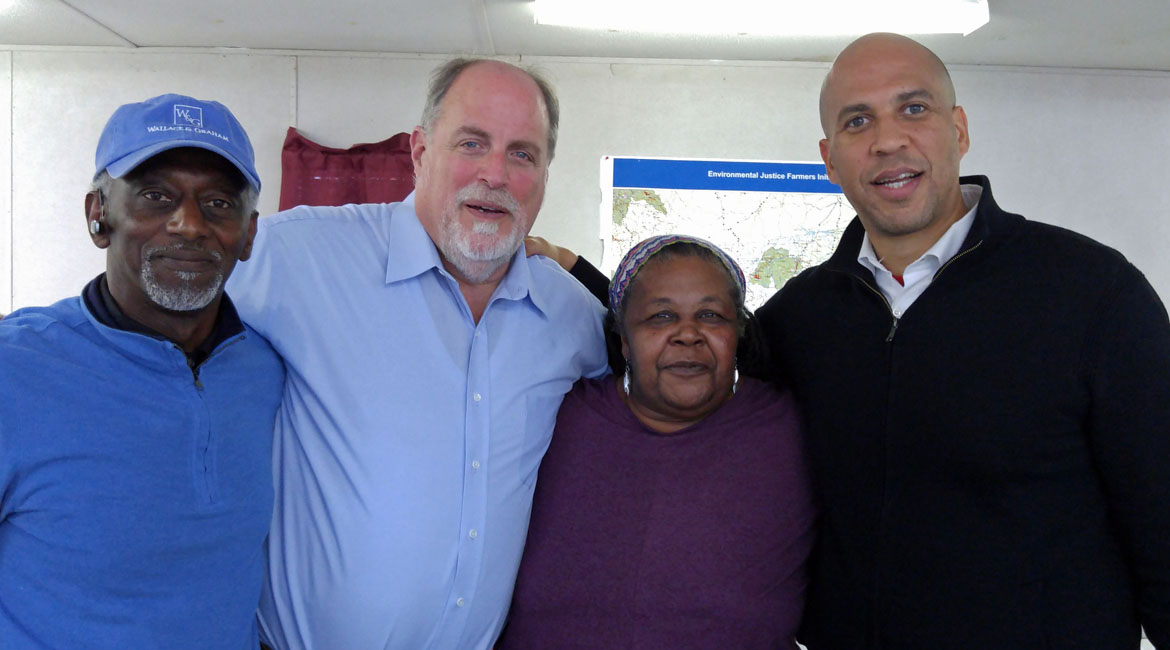Worth Fighting For: People, Clean Air and Water in North Carolina

Pictured above: Naeema Muhammed from the documentary Right to Harm
In September 2018, millions of gallons of toxic industrialized hog farm excrement inundated homes in Duplin and Sampson counties in eastern North Carolina, after floodwaters from Hurricane Florence caused the “waste lagoons” of nearby hog farms to overflow. The disaster was just the latest chapter in a long history of problems that began when these “concentrated animal feeding operations” (CAFOs) began moving into the region more than 35 years ago.

Naeema Muhammad, a community organizer and co-director of the North Carolina Environmental Justice Network, says the industrialized hog-raising operations aren’t just an environmental issue, they’re also an issue of social justice.
“In North Carolina, we have almost 10 million hogs, and almost all of them are in eastern North Carolina, in predominantly African American, Native American, and Latino communities,” she says.
Muhammad’s group helped organize a lawsuit against Smithfield Foods, a conglomerate that, through subsidiary companies, contracts more than half of the state’s hog farms. In the lawsuit, families that live near the hog farms claimed that air and water pollution from the farms was harming their health and had ruined their quality of life. “The industry seems to have more rights than the people,” Muhammad says, “but people are really trying to fight back.”
Community Leader
Muhammad grew up in North Carolina and spent time living in Philadelphia, where she became politically active. “Coming back to North Carolina, [I] began to see a whole lot of stuff that was wrong,” she says. Working with communities devastated by Hurricane Floyd in 1999, she saw how white and black communities didn’t receive the same help during the recovery process, with some African American residents being placed in temporary housing on a contaminated landfill site. That work led her to found the North Carolina Environmental Justice Network.
Now she’s back in the city where she grew up , Rocky Mount, in eastern North Carolina. “We call it the dumping ground of North Carolina,” she says. “Anything white people don’t want in their backyard you can find in eastern North Carolina.”
Eastern North Carolina is a rural area where small family farms used to be the norm. That began to change in the early 1980s, when industrialized hog farms started moving in. Over the next decade, the industry saw massive growth to more than 2,200 farms concentrated in a dense area.
“It used to be family farmers who were farming the land with other things. Some of them grew hogs, but they were raising them on the ground,” Muhammad says. When the industrialized farms moved in, they formed monopolies that left local farmers no choice but to become contract growers for the larger companies, she says. “When you look at those contracts, it’s just a simple form of slavery.”

Larry Baldwin, Devon Hall, Naeema Muhammed, Cory Booker
Vulnerable Communities
Muhammad says it’s no coincidence that it was predominantly communities of color where the farms moved in. “We don’t believe it was an accident,” she says. “We believe it was intentional, because these are poor communities with very little economic power and no political clout.”
According to a 2014 analysis by the University of North Carolina, African Americans are 1.54 times more likely to live within three miles of an industrial swine operation than whites, while Latinos are 1.39 times more likely and Native Americans are 2.18 times more likely.
Today, North Carolina ranks second in the country for hog farming, and it has the highest density of pigs in the United States, with a ratio as high as 45 pigs per person in places like Duplin County.
In addition to the sheer density of animals, it’s the methods used by these industrialized farms that has made life unbearable for neighboring communities. In CAFOs, the hogs are kept in close quarters in large covered sheds. Large fans blow putrid gases out of the sheds and into the open air, while pipes collect the animal waste that falls through the floor, funneling it to huge outdoor lagoons. When the ponds fill up, the waste is sprayed onto crops as fertilizer.
When animals die, their carcasses are left out in containers for collection, adding the smell of rotting flesh to the stench, Muhammad adds. “They can sit out there all day long,” she says.
Unlivable Conditions
The result for people who live nearby is air that’s saturated with the fumes of hog waste, including methane, hydrogen sulfide, and other toxins, Muhammad says. “People are breathing this stuff in on a daily basis, and it’s making them sick,” she says. “Health studies have shown that people living in communities near the hog farms have higher rates of asthma, upper respiratory problems, elevated blood pressure, and compromised immune systems,” Muhammad says. “The industry denies it, and they say that people are lying and making this stuff up.”
There’s also “a lot of anger and frustration from having to live like that,” she adds. Residents check the air quality in the morning to decide whether or not to leave the house. “They feel like prisoners in their own home,” she says. “They can’t open their doors and windows, they can’t hang their clothes on the line. They can’t do outdoor activities. Where they used to use their property to have family gatherings, children playing outdoors, cutting the grass, few people do that anymore.”
Some residents report that mist from the feces sprayers coats their homes and property, while the odor and waste has also led to an increase in pests like flies, mosquitoes, buzzards, and snakes.
Moving away from the farms isn’t an option for the families, Muhammad says. “Number one, most people living in those communities can’t afford to pick up and move. Number two, why should they move? They were living there first.”
Seeking Justice
Muhammad and NCEJN helped citizens of eastern North Carolina take their claims to court. More than 500 residents sued Murphy-Brown, Smithfield’s hog production division, saying the animal feeding operations were denying them the use of their property. In May 2018, a unanimous jury awarded the first group of 10 plaintiffs $50 million in damages.
The state of North Carolina subsequently reduced the award, citing a law that limits punitive damages to three times the amount of monetary damages, or $250,000, whichever is greater. The law also prohibits judges from informing juries of the limit. “That, to us, is an injustice,” Muhammad says. The state legislature also passed a law limiting the damages that can be awarded in nuisance lawsuits against agricultural operations, although the pending hog farm cases were eventually excluded after a public outcry.
Cleaning Up the Mess
While Smithfield has fought back by denying the residents’ claims and suggesting that groups like NCEJN were trying to shut down local contract farmers, Muhammad says that’s not true. Instead of shutting down the farms, her group is asking that Smithfield employ modern technology that will manage and dispose of waste in a way that’s more environmentally responsible than the lagoon and spray system. “We’re not trying to put anybody out of business, all we want them to do is clean up their mess,” she says. “They have the means to get this technology on the ground, but they will not do it, and the state will not make them do it.”
Even as they continue fighting for justice in court, Muhammad and NCEJN is also working with state regulators to enforce environmental laws and require pork producers to clean up their operations with modern waste management technology. “Our regulatory agency has the power to do that, but they haven’t done it because they’re so beholden to the pork industry,” Muhammad says. “Our hope is that we can get some legislators in there who will understand and be sympathetic to the people who put them office, and make the industry and the regulators do the right thing.”
North Carolina photos courtesy of Waterkeeper Alliance
What’s Next?
Learn about OMD’s work on the ground in North Carolina to support increased, equitable access to climate-fighting plant-based foods–– for people and the planet.


